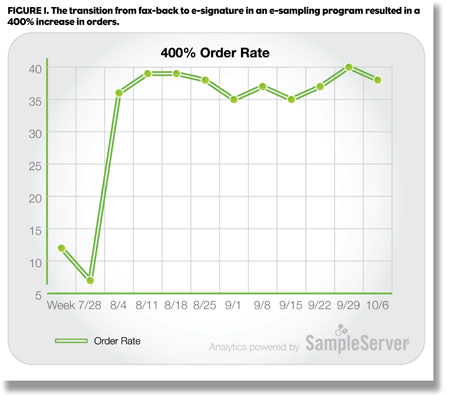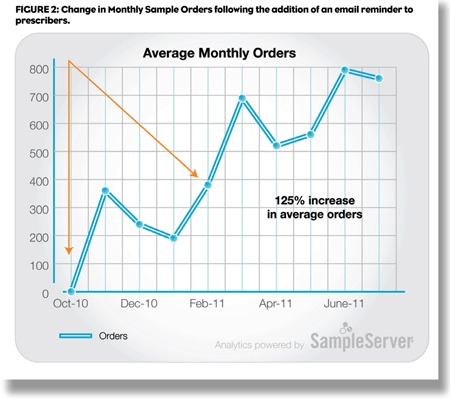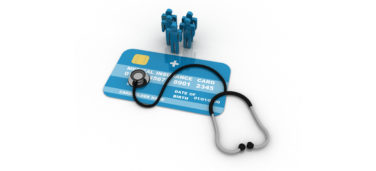First used in the early-2000s as a value-added service, e-sampling is fast becoming an essential marketing tactic to extend the functionality of web sites, mobile apps, and other digital tools being used to market to today’s busy prescribers and drive prescriptions.
Pharmaceutical companies are rediscovering a marketing tactic that can increase brand awareness, generate revenue, and bolster their sales force: e-sampling.
The first e-sampling programs were designed to reach physicians in white or virgin territories and included “Request for Samples” forms online that would notify a rep to visit a prescriber. Some websites included a downloadable fax-back order form used to request samples directly from the pharma company.
Today’s e-sampling experience should be on par with placing an order with Amazon.com (depending on the combination of vendors you choose). Ideally, e-sampling is totally digital, secure and compliant, and orders can be placed from a company’s professional site, doctor’s smartphone or iPad, and completed with an electronic signature. Doctors that opt-in receive vouchers, literature, reminders, marketing messages, and, if they request it, a visit from a live rep along with their product samples.
At its core, e-sampling is a permission-based, customer-centric, concierge-style marketing tactic. As it becomes ubiquitous and moves from brand sites to publishing sites, universal online sample closets, and even professional social media sites, the challenge will be how best to optimize its power.
WHY SAMPLE?
The traditional pharmaceutical marketing model was based on the office visit: The sales rep and the physician exchanged information and samples were delivered. Millions of samples were deposited in sample closets, but there was no guarantee that they were used.
As the industry grew its sales force, the number of reps actually seeing doctors decreased. At the same time, managed care increased physician workload and access to prescribers has become more difficult. By 2009, one of every five doctors in the United States was a “no see.” In 2010, that number jumped to one in four.
But prescribers want samples. Studies1 have shown that samples increase brand awareness and drive prescriptions. As pharmaceutical companies continue to look for ways to cut costs and reach doctors, e-sampling helps make marketing more customer-centric. Individual customers can be targeted based on their needs and samples they should receive. The analytics that accompany these digital tools can determine who orders, when, and how they respond to marketing campaigns. As a result, the percentage of physicians that actually use and evaluate a sample can be improved.
The goal of an e-sampling program should be the same as any customer-centric marketing model. According to Dave Chaffery’s definition2, “Customer-centric marketing is an approach to marketing based on detailed knowledge of customer behavior within the target audience [that] seeks to fulfill the individual needs and wants of a customer.” This approach helps the business gain direct insights into their customers to build a mutually beneficial relationship and rapport.
Based on this definition, the ideal e-sampling system must:
- Allow customers to request and receive samples on their own terms while at the same time giving a pharmaceutical company permission to develop a relationship and market regularly.
- Be customer-focused and customizable, offering a ‘concierge-style’ element to the prescriber-manufacturer relationship.
- Enable control, based on business processes and rules, with the brand determining how many samples are offered to what prescriber and how often.
- Allow the prescribers to provide pharmaceutical companies feedback via regular communications.
- Track measurable ROI on each sample.
FINE-TUNING A CUSTOMER-CENTRIC E-SAMPLING PROGRAM
In order to optimize the power of an existing e-sampling program, marketing practices may need to be adjusted to deliver relevant messages through multiple channels. This requires the use of proper business logic, automation, continuous marketing to prescribers, and leveraging your field force. Let’s examine each of these in detail.
BUSINESS LOGIC MATTERS
While it may sound cold and machinelike, defining your business logic can help you form successful relationships with your prescribers. As mentioned previously, companies initially deployed e-sampling programs to reach prescribers that were rarely, if ever, visited by sales reps. Now, business rules typically target a very specific specialty with their e-sampling programs and sometimes exclude high prescribers and, often, low potential prescribers.
Instead, high prescribers should be given digital access to samples while preserving the salesperson’s live interaction, because these doctors may prefer to order samples and access resources online. Why not let them so that they can evolve into brand loyalists?
Hospital-based providers, such as hospitalists, electrophysiologists, radiologists and residents who do not normally show up on most call plans can also serve to raise brand awareness. In addition, nurse practitioners and physician assistants are rarely targeted by sales reps but write nearly 750 million prescriptions each year and should be able to participate in these programs.
Recently, a midsize pharmaceutical company added nurse practitioner-targeted sampling to their e-sampling site. Within two weeks, NPs made up 20 percent of the sample requests. Let’s do a little math here: If your brand received one million prescriptions from NPs and PAs and the average Rx is $69.913 that is an additional $69,910,000.00. How long do you really want to wait to get a million more prescriptions for your brand?
Colleague referral continues as one of the strongest influencers of prescription decisions. If a low- or no- decile doctor finds his or her way to your online brand, why not allow them to order a minimum number of samples and have a rep follow up with a sales call?
One of the benefits of e-sampling as a customer-centric marketing tactic is that your business rules are not static. You can quickly and easily make an informed decision, change your targets and your relationship-building tactics based on analytics that tell you in real-time what is working and what is not.
OPTIMIZE THE HUMAN ELEMENT
In 2011, most prescribers are used to one-click shopping and the sample ordering experience should be as simple as an electronic shopping transaction. After all, it’s likely that an HCP will be online at other websites immediately before or after ordering samples. In addition, the prescriber will expect the e-sampling program to be 100% PDMA and 21 CFR Part 11 compliant.
If an HCP must fill out a sample request form, print it, then fax it to receive samples, you will probably lose a customer. Fax-back programs lead to drastically reduced participation since the procedure requires multiple steps and devices and infringes on a physician’s time.
In Figure 1, a pharmaceutical client saw their e-sampling program participation increase by more than 400 percent when they transitioned from a fax-back program to electronic signature.

The e-sampling user experience should be reduced to its simplest level: choice. The only action that should be required is to choose your product. For this reason, the use of e-signature is fast becoming the preferred choice for completing e-sample requests. If your e-sampling program doesn’t use e-signature, test its use to see how order rates change once it’s implemented.
DON’T STOP MARKETING
Over-marketing can create negativity or worse, apathy, when applied to most types of Internet content. In the case of e-sampling, however, reminding busy prescribers that they have “samples ready to order” is a welcome value-added service and builds upon your burgeoning relationship.
The optimal reminder should be tailored to the prescriber’s preferred method of communication. Many physicians prefer email reminders but younger, Generation X or Generation Y prescribers may prefer notifications via text message. Reminders could also be made available on social media sites.
The simple “Dr. Reader, You now have samples available” reminder is powerful. In the example (Figure 2), the company focused their promotions using branded banners. After a few months the company became frustrated with the program’s low participation.

The e-sampling provider intervened with a regular e-email reminder and the number of orders doubled in the space of one day and maintained a healthy growth. The e-sampling program should also leverage the assets and content being created for all other brand-related marketing programs so that both marketing and e-marketing teams can learn from each other’s successes and challenges.
LEVERAGE YOUR SALES FORCE
Rep-based sampling and e-sampling operate on the same business principles and should be tied together around allocations and analytics. The field force can leverage the digital channel as a resource to increase the value they bring to prescribers.
The most successful e-sampling programs are ones where the field force leads the charge. Pharmaceutical companies that involve reps can leverage their relationships to recruit prescribers into the program and can use the reps’ insights to tailor the marketing program.
Once the program is up and running, reps can use the e-sampling program’s analytics to determine which physicians order when and how often. They can then tailor their call schedules around online behavior.
If the e-sampling program allows it, the rep can communicate directly with the physician, asking him or her if a visit is called for and letting the physician know when new information is available. Because the physician is being reminded on a regular basis that samples are available, the rep has time to focus on physicians who haven’t been called on, who haven’t responded to invitations to join the program, who have joined but haven’t reordered, and those who are seeking insights about the product.
A FEW WORDS ABOUT COMPLIANCE
Operating an e-sampling system within a controlled, compliant environment inherently reduces the company’s risk exposure compared to traditional physical sampling. At any given time, a company using e-sampling will know when, where, to whom and how much of a product is sampled. There is less risk of diversion and no physical inventory to manage because orders go through the e-sampling engine directly to the fulfillment vendor.
The lack of physical inventory automatically creates cost efficiencies on the operational side. E-sampling generates very clean reporting and electronic records from which your brand can easily manage its sample accountability programs and regulatory requirements, such as the Physician Payments Sunshine Act 2012 (PPSA).
CALCULATING ROI – AN EASY EQUATION
A top 10 pharma company with a smaller, mature product averaged 50 online sample orders per week (Figure 3). They had an amazing sample-to-prescription ratio (almost 1 to 1), so an additional fifty prescriptions were being written each week. At a retail price of $135/month for 12 months, the e-sampling function on their professional site was producing approximately $81,000 of annualized retail revenue per week.

If your e-sampling program generates a conservative 100 sample requests per day and the brand calculates a 3 to 1 sample to prescription ratio, then the online function has created 30 new prescriptions that otherwise may not have been written. These numbers quickly compound as digital marketing messages and reminders continue throughout the life of a program.
Using the analytics of an e-sampling program you should easily be able to:
- Determine your sample to new prescriptions ratio
- Determine your sample to total prescriptions ratio
- Predict the ROI of your current sampling model based on physical sampling
- Compare the costs of one field rep and the e-sampling program
- Determine how often a rep is invited to visit a prescriber
- Calculate the overall ROI of the e-sampling program
THE BOTTOM LINE
The shift to customer-centric marketing will not succeed if your approach is too radically different from your present marketing practices. On the other hand, with sales force reductions, the increased difficulty of detailing physicians, and the rise of digital marketing tools, e-sampling is an easy tactic to deploy to extract the best elements from a traditional sales visit and optimize them for the digitally savvy prescriber.
The insights you get from an e-sampling program allow you to analyze and segment your customer base—information that should be shared with your internal and external sales reps and marketing team. Synchronizing messages and marketing offers will help convince customers that you are focused on them.
One final thought: It takes time to implement a successful e-sampling program. It requires constant nurturing and the refining and re-refining of messages and targets. It is critical to recognize that this effort requires persistence and patience. But in the end, your brand will be rewarded with more prescriptions from satisfied prescribers.
REFERENCES
1. J.M. Boltri, E.R. Gordon, and R.L. Vogel, “Effect of Antihypertensive Samples on Physician Prescribing Patterns,” Fam Med 2002; 34:729-31 and R.F. Adair, L.R. Holmgren “Do Drug Samples Influence Resident Prescribing Behavior?” Am J Med. 2005 Aug;118:881-4.
2. http://www.davechaffey.com/E-marketing- Glossary/Customer-centric-marketing.htm
3. Kaiser Family Foundation.







